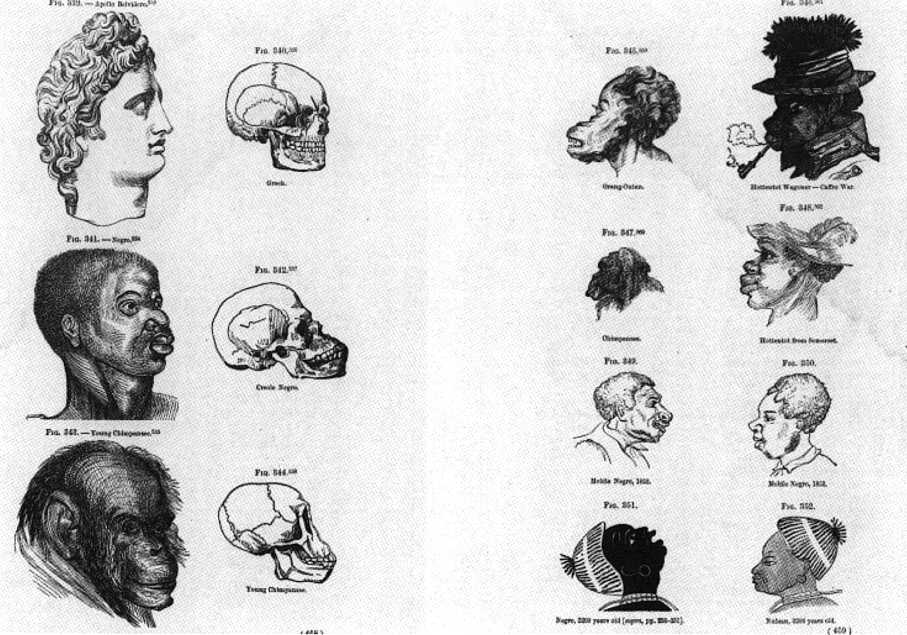The images above are from a text entitled Crania Americana, written by Dr. Samuel George Morton and published in 1839. Morton was an American doctor and professor at the University of Pennsylvania who, through the ‘science’ of craniology, determined that there was evidence to support a racial hierarchy. The images above are nothing short of gross caricatures of actual human beings. They are so outlandishly unrealistic that it is difficult to characterize them as scientific by any means. Let us take a moment to focus on the three sketches on the left hand page of the bottom image. Morton argued that racial differences were actually distinctions between separate species, and here is attempting to display the external and internal physical markers. I assume that Morton is visually establishing his notion of species/race hierarchy beginning with the top caucasian bust, moving on to the highly stereotypical distortion of a brown skinned man, and finally ending with an ape. Next to each figurehead is a sketch of what Morton claims to be their skulls. Morton believed intelligence and general mental attributes to be directly related to brain size, and therefore skull size and shape.
While I am by no means a physical anthropologist, I call into question the, for lack of a better word, reliability of Morton’s sketches. This, however, is an excellent example of how unreliability is present not only in the fictional literary sphere but reflected in the laws, public education, and popular general knowledge and ideology of a certain moment in history that we generally perceive to be factual. I believe what strikes me as the most audacious aspect of this text, this man, and these beliefs are that they were widely accepted as a scientific truth and were used as a justification for the exploitation of other ethnic groups by white men. Morton was a professor and his claims were backed by a powerful academic institution. This are not the claims of one extremely racist individual but are instead a point that was collectively agreed upon by many scientific, academic, and political leaders.
In terms of our readings, I believe Morton’s Crania Americana ties in well with a better critical understanding of Conrad’s Heart of Darkness. Published in 1899, it is reasonable to assume that Conrad had access to Morton’s writings, or at least similar ones. As Christine mentioned in class, craniology is mentioned in the text itself. When Marlowe is being inspected before his trip, the doctor asks, “in the interests of science, to measure [his] crania” (11). Marlowe asks the doctor if there has ever been a difference in the cranial measurements before and after a trip to the Congo, to which the doctor replies, “the changes take place inside, you know” (11). I would argue that this may be a way in which Conrad is commenting against scientific racism, insomuch as in this moment, there is an acknowledgement that changes within humanity occur internally and cannot be measured.
While I am by no means a physical anthropologist, I call into question the, for lack of a better word, reliability of Morton’s sketches. This, however, is an excellent example of how unreliability is present not only in the fictional literary sphere but reflected in the laws, public education, and popular general knowledge and ideology of a certain moment in history that we generally perceive to be factual. I believe what strikes me as the most audacious aspect of this text, this man, and these beliefs are that they were widely accepted as a scientific truth and were used as a justification for the exploitation of other ethnic groups by white men. Morton was a professor and his claims were backed by a powerful academic institution. This are not the claims of one extremely racist individual but are instead a point that was collectively agreed upon by many scientific, academic, and political leaders.
In terms of our readings, I believe Morton’s Crania Americana ties in well with a better critical understanding of Conrad’s Heart of Darkness. Published in 1899, it is reasonable to assume that Conrad had access to Morton’s writings, or at least similar ones. As Christine mentioned in class, craniology is mentioned in the text itself. When Marlowe is being inspected before his trip, the doctor asks, “in the interests of science, to measure [his] crania” (11). Marlowe asks the doctor if there has ever been a difference in the cranial measurements before and after a trip to the Congo, to which the doctor replies, “the changes take place inside, you know” (11). I would argue that this may be a way in which Conrad is commenting against scientific racism, insomuch as in this moment, there is an acknowledgement that changes within humanity occur internally and cannot be measured.


I can see how this supports the idea that there is a difference between race and social level. When science is used to create a gap between races, the superior one tends to take advantage of the weak one. This can be seen as a form of evolution, and when discussed in regards to imperialism, we see the idea of the uncultured “Others”, where they were seen as the primal form of humans that were in great need of help -- to fully utilize all the material that was at their disposal for economic gain or political power. This picture depicts the “Other” in a bad light, and helps spread the un-educated peoples’ belief that the Africans needed to be spoken for, as well as, used for labor. The way that they are depicted creates an idea that they closely resemble an animal, not only physically, but mentally, when compared to an actual human being. The fact that in your image, the skull and drawings resemble animals, and the white male resembles a greek goddess, says it all. (I believe that this tactic is condescending, and used to dehumanize and humiliated them.)
ReplyDelete